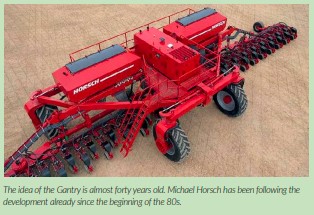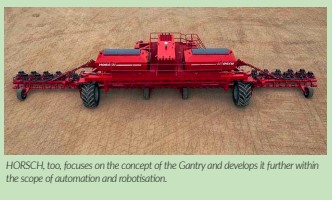HORSCH has been pursuing topics like automation and robotisation for quite some time. Michael Horsch tells us how the idea for the Gantry was born, how it develops further and where the journey will lead to.

How did HORSCH come up with the idea of the
Gantry?
We have been dealing with the aspects of automation and the construction of robots for farming for quite a long time. The trigger for the Gantry was a problem that mainly came from South America. For approx. five to six years, we have been selling our 18 metre Maestros over there, especially in Brazil, to large soya and maize farmers. These farms have understood how a reasonable cultivation strategy works on their sites, they seed directly and successfully manage catch crops. Thus, there are more humus and nutrients in the soil, and it can keep more water. Catch crops have become the key for progress in Brazil – especially the right catch crop mixtures, sown properly and at the right time. Thus, direct seeding works without tillage and loosening in the long term. Only on sandy soils do you have to loosen the soil additionally– a pass you can use in turn to place a fertiliser depot in deeper layers. However, the problem of most of the farmers over there is that they do not get enough employees for the cultivation of their large fields. This is why they prefer to have one or two larger machines than several small ones.
The requirement are machines with 24 m or even larger working widths. But from an engineering point of view there is a magical limit – 18 m. It still folds easily, the machine weight is relatively low and it is very stable. From 24 m, the machines become very heavy, and the weight is where you need it least – namely in the middle. To be able to cope with the powers during the folding process, this is where much stability and thus weight is required. We focused on this problem and discussed what would make sense to prevent the machine from becoming too large and too heavy but still heavy enough for direct seeding and especially with a good distribution of the weight over the whole working width. This is why we came up with the idea of the Gantry. However, we did not invent it.
Where does the idea for the Gantry originally
come from?
The idea for the Gantry already is about 40 years old. Since the beginning of the 80s, I have been following this development in England, e.g. at the National College of Agricultural Engineering in Silsoe. Today, besides us, some companies deal with this idea – with quite interesting applications – and also with the aspect of automation. Many manufacturers, universities and start-ups often focus on small, all-electrically driven robots. They mainly think of a use in clusters. There already are companies that commercialise it. We took a look a Farm droid and we noticed that the people working there are very pragmatic young people who have an agricultural background. They tackle the subject with a very practical approach what, in my opinion, makes the whole thing feasible rather quickly. If you try to work theoretically and to realise things on small test fields, you will proceed much slower.
To begin with, we focused on large working width, fully automated sowing processes etc.
Especially large 12 and 18 m seed drills which fold towards the front and have compact transport widths and large hoppers can be automated quite well. Of course, we have to continue to make tests and to develop ideas. In past years during which we carried out test runs with the robots, one of our first findings was that there are only little possible savings with regard to staff. The tasks only change when you do no longer sit in the cabin, but you have to check that the machine does what it is supposed to do and you permanently optimise the adjustments for an optimum work result – and all this often by simply running after the machine.
What will it be like in the future?
We are proceeding quite fast, but there still is a lot of software work to do, e.g. with regard to track planning or surroundings detection. And there is a lot of know-how. But we are only proceeding this fast due to our test efforts in the field, especially on our own test farm Agro Vation. We already tackled the subject of Controlled Traffic Farming about twelve years ago. We wanted to see if you can get more efficiency out of the machines and if it has an effect on soils structure and thus on the yields if you make all passes on one fixed track and no longer drive over the rest. We learnt that this also was the first step towards robotics, that we have to plan the tracks and digitalise the fields. From an agronomic point of view, however, Controlled Traffic did not achieve what we hoped for. At the harvest, it makes most sense to move the high loads on fixed tracks. Especially during the maize harvest, it often is wet and the wheat that is grown after the maize suffers. In this case, CTF is very advantageous. Now and then we noticed a few effects on heavy soils. If it was wet and in case of fixed tracks, there were small effects in the population development and in the yields in a one-digit percentile range.

What was also obvious: if tillage is exclusively been carried out with CTF, the soils inevitably become uneven. In Australia, where farmers have been working with direct seeding and CTF for years, the farmers made the same experiences. If you drive on the track in the same direction every year, the result are longitudinal and cross corrugations. And this affects tillage and sowing quality as well as the operational speed for example when spraying. We also partly noticed that it is quite difficult to follow the soil with a combine if there is lodged grain. And in addition: If you drive in a fixed track, the track – no matter where it is – becomes a “dirt track”. Everyone knows what becomes of a dirt track after several years. There are potholes, it is uneven and especially if it is wet, it is very difficult to drive on.
What does the HORSCH Gantry solution look like? How did it develop further?
Our motivation was: We do not want to build another heavy machine that compacts the soil. We choose the Gantry way – with two wheels at the front, two at the rear and the frame is positioned between the wheels. In our case, the front axle is wider – it is based on a 12 m track. The rear axle is based on a 4 m track. The reason is that in this case it isn’t one single track that is always driven over twice. For if it is wet and you drive over the same track twice, even between the rows, you might cause quite amess resulting in intense compactions. Last year around Christmas during Covid my brother and I again discussed this subject and suddenly we had the idea not to build a 24 m maize seed drill which with too small wheels and too much weight in the middle section would only be a bad compromise but to design the machine as a robot. This is how the Gantry idea was born – in a slightly modified form with the frame in the middle etc. At the beginning of January, we brought one of our engineers into the project to complete the design and to build the machine.
What is the current state of affairs? Are there
still any problems?
We are currently in the test stage. At the end of May, the Gantry was sent to Brazil to carry out tests on large fields. In Germany, the options for these tests are few – the Gantry is too wide and has no homologation for road service. What we are still working on is the software issue. It is quite easy to solve from a technical point of view. As always, the main work is carried out by the software. But there still is along way to go until the sensor system makes the machine react fast enough, until everything does what it is supposed to do. What is again and again proven during the field tests is that you can achieve a significantly higher efficiency and work quality if you do without a cabin. The cabin sometimes is diverted from its intended use to take a little rest. But the advantage also is that you gain a lot of installation space. Accessibility is improved considerably. You can access everything – even from below. The design of the frame, especially of the main frame, is simple, elegant and first and foremost particularly stable.
This way, you can also build wider machines. With our concept, we could go to 30 or even 36m. Due to the large hoppers, we generate a wider coverage, and we can place them where most of the weight is required. Of course, you will eventually reach a limit of what four wheels can carry. 40 to 50 t on the wheels will be critical, especially with regard to the turning process if the seed frame is lifted or in wet conditions. The whole machine almost weighs 30 t, plus 10 to 15 t of seed – the weight quickly adds up. But still the concept is more manageable than a design with separate parts. When sowing directly, the weight has to be distributed evenly to where the row bodies are positioned, even right outside. The wider the machine is, the more difficult it is to put this into practice.
Which sectors can be automated with such
ideas?
With regard to automation, in my opinion it is important to tackle the topics that can most easily be put into practice, that have to do with sowing, plant protection, fertilisation and mechanical weed control. Tillage does not have top priority. It is not so complicated and is more or less carried out alongside. To automate harvest processes, however, is extremely complicated. We are far from having a harvest machine drive on the field without a driver – no matter if it is a combine, a potato or a sugar beet harvester. In this sector, there are way too many influencing factors. Everyone who has ever threshed for example lodged grain with a combine knows what a challenge it is.